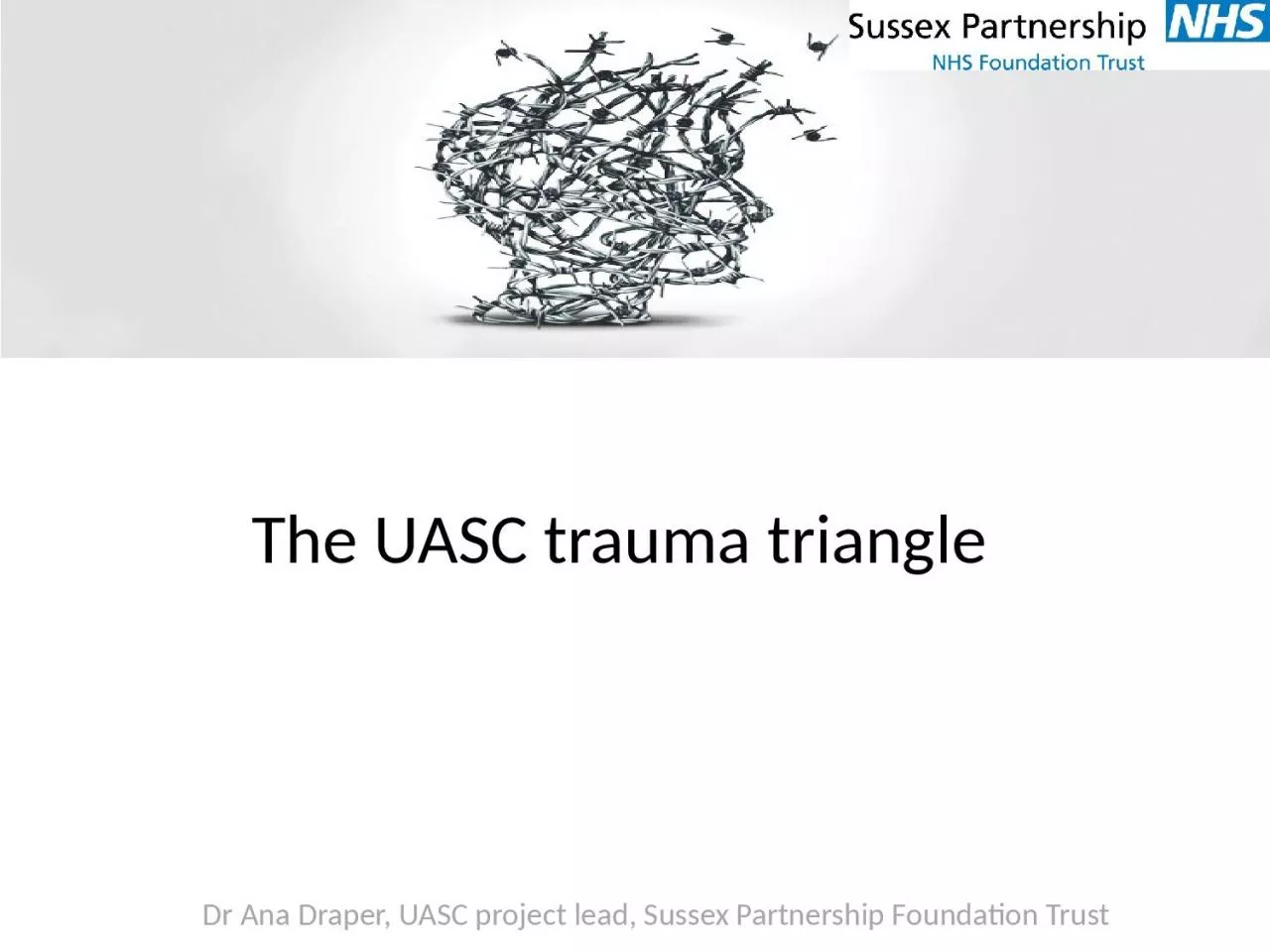

The UASC trauma triangle Dr Ana Draper UASC project lead Sussex Partnership Foundation Trust Many UASC experience trauma In the country from which they have fled On the migration journey to the UK ID: 935862
Download Presentation The PPT/PDF document "Dr Ana Draper, UASC project lead, Sussex..." is the property of its rightful owner. Permission is granted to download and print the materials on this web site for personal, non-commercial use only, and to display it on your personal computer provided you do not modify the materials and that you retain all copyright notices contained in the materials. By downloading content from our website, you accept the terms of this agreement.
Slide1
Dr Ana Draper, UASC project lead, Sussex Partnership Foundation Trust
The UASC trauma triangle
Slide2Dr Ana Draper, UASC project lead, Sussex Partnership Foundation Trust
Many UASC experience trauma:
In the country from which they have fled
On the migration journey to the UK
In the asylum and assimilation process once they have arrived in the UK
Slide3Dr Ana Draper, UASC project lead, Sussex Partnership Foundation Trust
Outcomes of trauma experience:
Higher incidence of PTSD in this population
Trauma symptoms on arrival to the UK which need to be processed
High levels of negative cognitions
High levels of disturbance
Reduced resilience and ability to manage the day to day activities
Slide4Dr Ana Draper, UASC project lead, Sussex Partnership Foundation Trust
Operational requirements:
The inclusion of the cohort as a high risk group in trauma pathways
A watch wait and see protocol to ensure that vigilance is maintained
Slide5Dr Ana Draper, UASC project lead, Sussex Partnership Foundation Trust
The Fast Feet Forward;
E
arly Intervention Trauma Program
Slide6Dr Ana Draper, UASC project lead, Sussex Partnership Foundation Trust
What is the Fast Feet Forward Trauma
P
rogram?
It acknowledges that trauma is present
It is culturally sensitive and age specific
It is none pathologising and normalising of trauma symptoms
It is an early intervention that increases resilience and supports
self-management
Slide7Dr Ana Draper, UASC project lead, Sussex Partnership Foundation Trust
UASC hotspots:
In EMDR ‘hot spots
’
are understood to be parts of trauma memories
that
cause high levels of emotional distress, and that are often
re-experienced
, either by internal triggers, or by external,
current
triggers which re-activate the original memories and distress.
Slide8Dr Ana Draper, UASC project lead, Sussex Partnership Foundation Trust
UASC hotspots:
The hotspots that produce high levels of disturbance linked to trauma
experiences are:
Immigration
Accommodation
Lack of language/communication
Past memories
Lack of education
Lack of sleep
Slide9Dr Ana Draper, UASC project lead, Sussex Partnership Foundation Trust
Continued……..
UASC hotspots:
The hotspots that produce high levels of disturbance linked to trauma
experiences are:
Lack
of transport
Experiencing
racism
Loss of physical health
Interaction with the police
Slide10Dr Ana Draper, UASC project lead, Sussex Partnership Foundation Trust
The Fast Feet Forward Trauma Program
Group
Dialogical and relational intensity (12 sessions over 6 weeks)
Bilateral fast feet movements that link to sport
Slide11Dr Ana Draper, UASC project lead, Sussex Partnership Foundation Trust
What Fast Feet Forward does:
Increases the validity of positive cognitions
Reduces the disturbance level
Produces self management strategies
Increases learning potential
Creates a foundation for healthy living patterns
Slide12Dr Ana Draper, UASC project lead, Sussex Partnership Foundation Trust
Case example:
AK is a 17yr old Sudanese Unaccompanied Asylum Seeking Child who had
been
imprisoned and experienced torture before fleeing to the UK. He left
his
mother and younger sibling and was terrified that they would be harmed.
He
reported flashbacks and the inability to sleep in his bedroom as the colour
and
shape of it reminded him of his prison cell in the Sudan.
Slide13Dr Ana Draper, UASC project lead, Sussex Partnership Foundation Trust
Case example:
This is part of the therapeutic conversation with AK two months after the
fast
feet forward trauma program. In this time he had turned 18, lost his SW,
was
told he needed to move from his accommodation and his mother who is still
in
Sudan was ill and needed surgery. He was also awaiting a court hearing and his
transport
grant had not materialised making it difficult for him to attend college.
Slide14Dr Ana Draper, UASC project lead, Sussex Partnership Foundation Trust
Person
What was said:
Ana
I can see that lots of difficult things have been happening.
AK
Yes, it’s been difficult.
Ana
I’m wondering what has helped you to cope; you look different, like you are managing somehow?
AK
I did what you taught me.
Ana
What I taught you?
AK
Yes, you know, running.
Ana
So you ran?
AK
Yes when I was sad or scared, I ran.
Ana
And what did that do?
AK
It made it better, it changed things, and it helped me to cope.